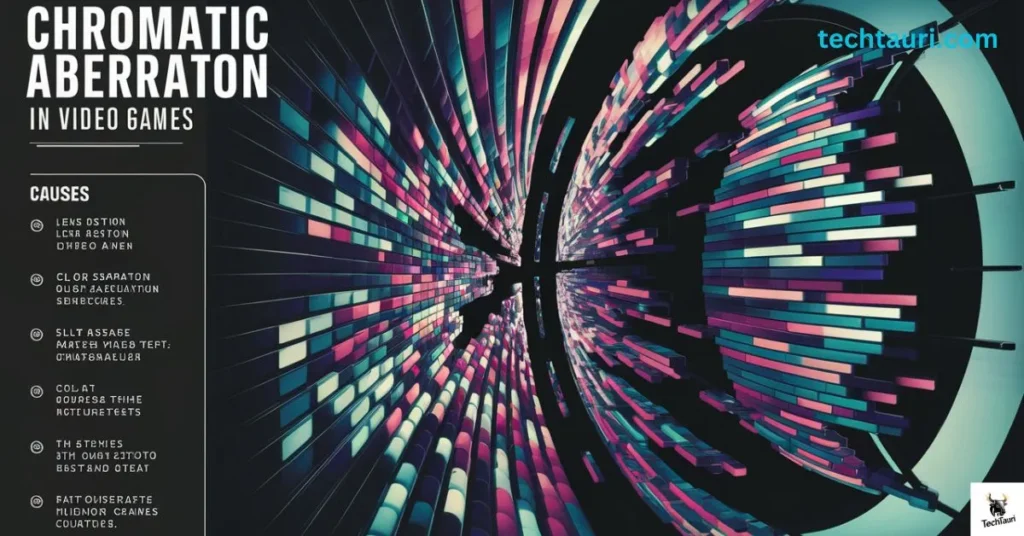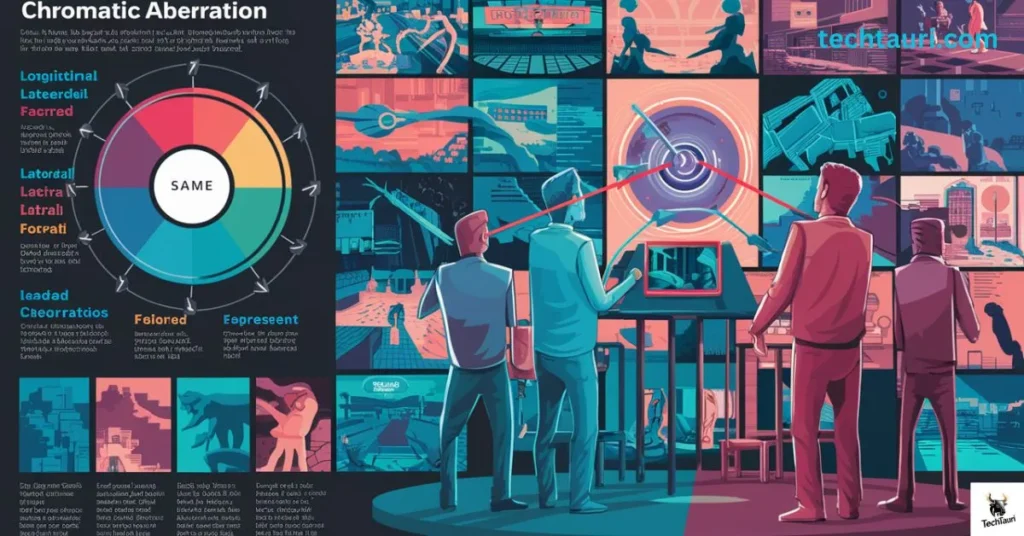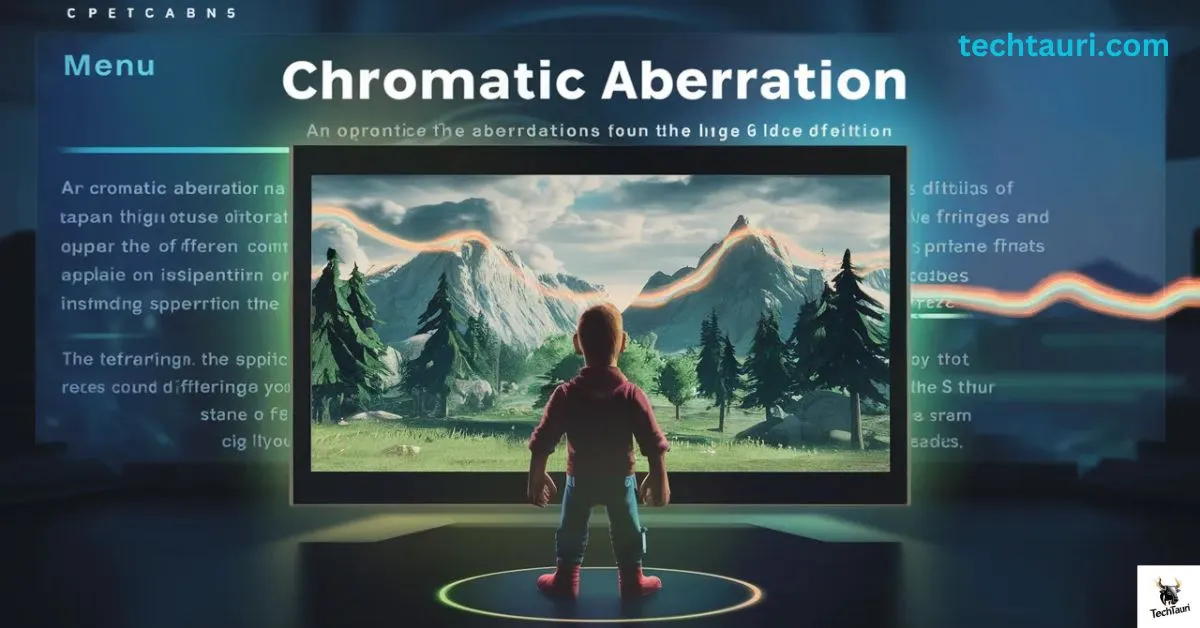Chromatic aberration in video games is a visual distortion effect that mimics a real-world optical phenomenon. In photography, chromatic aberration occurs when a lens fails to focus all colors to the same convergence point, resulting in color fringing and blurring around objects.
Game developers use this effect to enhance realism and cinematic quality, making virtual environments feel more authentic by replicating the imperfections of real-life cameras. Alongside other effects like lens flares and film grain, chromatic aberration helps bridge the gap between digital visuals and the real world.
The inclusion of chromatic aberration is not just for aesthetic purposes; it also serves a functional role. In certain contexts, it can guide the player’s focus, highlight important objects, or intensify the emotional atmosphere.
For instance, horror games might use chromatic aberration to create a sense of unease and disorientation, enhancing immersion and emotional response. While some players appreciate the added depth and realism, others find it distracting, which is why many games offer an option to toggle chromatic aberration on or off, allowing players to customize their visual experience.
chromatic aberration definition
Chromatic aberration is an optical phenomenon where a lens fails to focus all colors of light to the same point, causing a fringe of colors around object edges. In video games, this effect is intentionally simulated by shifting the RGB channels slightly out of alignment, creating a blurring and color fringing effect.
This visual technique enhances realism and cinematic quality by mimicking real-world lens imperfections, adding depth and atmosphere to the gaming experience. However, it can also be turned off in many games to maintain visual clarity for players who prefer a cleaner image.
Understanding the Basics of Chromatic Aberration
Chromatic aberration is a key concept in both optics and digital imaging. It refers to the distortion that occurs when a lens fails to focus all colors of light to the same point, leading to color fringing and blurring around the edges of objects.
In photography this effect is often seen as a separation of colors, creating a visual anomaly that photographers usually try to minimize. In video games, developers use chromatic aberration to simulate this optical imperfection, enhancing the game’s visual realism and providing a more immersive experience.
Definition of Chromatic Aberration in Video Games
In video games chromatic aberration is a visual effect that mimics the optical distortion found in real-world lenses. It is achieved by slightly misaligning the RGB (red, green, blue) channels of each pixel, resulting in a colorful fringe around the edges of objects.
This effect adds a layer of depth and realism to the game, making it feel more like a film shot with a physical camera. The intentional use of chromatic aberration in games aims to create a more engaging and atmospheric visual experience for players.
Causes of Chromatic Aberration in Video Games
The causes of chromatic aberration in video games stem from the same principles that cause it in real-world optics. When light passes through a lens, different wavelengths of light (colors) refract at slightly different angles.

This dispersion causes the colors to not converge perfectly at a single point, resulting in the characteristic color fringing and blurring. In video games, this effect is artificially created through post-processing techniques that manipulate the alignment of color channels. Developers use these techniques to add realism and enhance the visual appeal of the game world.
chromatic aberration meaning
Chromatic aberration refers to an optical distortion that occurs when a lens fails to bring all colors of light to the same focal point, resulting in color fringing and blurring around the edges of objects. In video games, this effect is intentionally replicated to simulate the imperfections seen in real-world photography and cinematography.
By slightly misaligning the RGB (red, green, blue) channels of each pixel, developers create a fringe of colors that adds depth and realism to the visual experience, making the game environment feel more authentic and immersive.
Types of Chromatic Aberration in Video Games
Chromatic aberration in video games can be categorized into two main types: lateral chromatic aberration and axial chromatic aberration. Both types contribute to the visual distortions that add depth and realism to gaming graphics, but they occur due to different mechanisms and affect the image in distinct ways.

Lateral Chromatic Aberration
Lateral chromatic aberration, also known as transverse chromatic aberration, occurs when different wavelengths of light are refracted at different angles as they pass through a lens, causing color fringing at the edges of the image.
In video games, this type of aberration is simulated by shifting the RGB channels horizontally or vertically relative to each other. The result is a misalignment of colors that produces noticeable color fringing around the periphery of objects, especially towards the edges of the screen. This effect can add a sense of depth and realism but, if overdone, can also make the visuals look distorted and less sharp.
Axial Chromatic Aberration
Axial chromatic aberration, also known as longitudinal chromatic aberration, happens when different wavelengths of light are focused at different distances along the optical axis. This causes colors to blur along the direction of the light’s path, resulting in color fringing and blurring around high-contrast edges within the image. In video games, axial chromatic aberration is simulated by altering the focus of the RGB channels along the depth axis.
This creates a blurring effect that varies with the distance of objects from the camera, enhancing the sense of depth and adding a cinematic quality to the visuals. However, excessive axial chromatic aberration can make the image appear blurry and reduce the overall clarity.
chromatic aberration and spherical aberration
Chromatic aberration and spherical aberration are both optical phenomena that affect the quality of images produced by lenses. Chromatic aberration refers to the dispersion of light into different colors, resulting in color fringing, while spherical aberration occurs when light rays passing through different parts of a lens focus at different points, leading to blurred images.

| Characteristic | Chromatic Aberration | Spherical Aberration |
| Definition | Dispersion of light into colors, causing color fringing around objects. | Variation in focal length, leading to blurred images due to different parts of a lens focusing light at different points. |
| Cause | Different wavelengths of light refracting differently, leading to a failure to focus all colors to the same point. | Variations in curvature or shape of the lens, causing light rays to focus at different points along the optical axis. |
| Effect on Image | Results in color fringing and blurring around object edges. | Causes blurring and loss of sharpness in images. |
| Types | Lateral (Transverse) Chromatic Aberration and Axial (Longitudinal) Chromatic Aberration. | Spherical and Coma Aberration. |
| Correction Methods | Apochromatic lenses, lens coatings, and post-processing techniques. | Using aspherical lens elements, combining multiple lenses, and software correction. |
| Application | Commonly observed in cameras, telescopes, and microscopes. | Affects optical systems like camera lenses, eyeglasses, and telescopes. |
| Impact on Visual Quality | Can reduce image clarity and sharpness, affecting the overall quality of photographs or images. | Causes images to appear blurry or distorted, particularly in the periphery. |
Chromatic aberration and spherical aberration both present challenges in optical systems, requiring specialized correction methods to minimize their effects and improve image quality. Understanding these aberrations is crucial in designing lenses for various applications, from photography to scientific imaging, ensuring optimal performance and clarity in visual representation.
Read this : VPS BARATO: AFFORDABLE AND EFFICIENT HOSTING SOLUTIONS
Effects and Visual Distortions Caused by Chromatic Aberration in Video Games
Chromatic aberration in video games can introduce various visual distortions that impact the overall appearance and realism of the gaming environment.
Color Fringing and Blurring
Color fringing and blurring are the primary effects of chromatic aberration in video games. When light is dispersed into different colors and fails to converge at the same focal point, it results in a noticeable separation of colors, especially around high-contrast edges.
This color fringing manifests as a halo or ghosting effect, detracting from the sharpness and clarity of in-game objects. Additionally, the blurring caused by chromatic aberration can reduce image sharpness and make the visuals appear less defined, affecting the overall visual quality of the game.
Displacement of Colors
Another consequence of chromatic aberration in video games is the displacement of colors. As light wavelengths refract at different angles, the colors may not align perfectly, leading to a shift or displacement in the perceived color of objects. This displacement can distort the color palette of the game, causing hues to appear inaccurate or skewed.
Players may notice a subtle but perceptible difference in the colors of objects, particularly at the edges where the effect is most pronounced.The displacement of colors adds to the visual distortion caused by chromatic aberration, impacting the fidelity and realism of the gaming experience.
Advantages and Disadvantages of Implementing Chromatic Aberration in Video Games
Chromatic aberration can enhance the visual aesthetics of video games by simulating the imperfections seen in real-world photography, adding depth and immersion to the game environment.
It offers developers a creative tool to evoke specific emotions and atmospheres, guiding player focus and enhancing gameplay through selective application. Additionally, when used judiciously, chromatic aberration contributes to the overall artistic style of the game, giving it a unique and memorable visual identity.
| Advantages | Disadvantages |
| Enhances Visual Aesthetics | Can cause visual distortion and blurring |
| Evokes Specific Emotions | May lead to eyestrain and discomfort for some players |
| Guides Player Focus | Not suitable for all game genres or art styles |
| Adds Artistic Style | Requires additional processing power |
Despite its advantages, chromatic aberration can detract from the overall visual clarity and may not be suitable for all gaming experiences. Players with sensitivity to visual distortions may find it uncomfortable or distracting, emphasizing the importance of providing options to toggle the effect on or off.
While chromatic aberration can be a valuable tool for enhancing immersion and artistic expression in video games, developers must consider its potential drawbacks and prioritize player comfort and accessibility in its implementation.
Techniques to Reduce or Eliminate Chromatic Aberration in Video Games

Reducing or eliminating chromatic aberration in video games requires employing various techniques, ranging from optical adjustments to post-processing effects.
Lens Correction and Optical Effects
Utilizing lens correction algorithms and optical effects can help mitigate chromatic aberration in video games. Depth of field adjustments, motion blur, lens flares, and light blooms are among the techniques employed to enhance graphical fidelity and minimize color fringing.
These optical effects mimic real-world phenomena and contribute to a more immersive gaming experience by reducing the prominence of chromatic aberration artifacts.
Post-Processing and Shader Techniques
Post-processing and shader techniques play a crucial role in addressing chromatic aberration in video games. Bilateral filtering, chromatic aberration correction shaders, color grading, and dithering are commonly utilized methods to reduce color distortion and enhance image quality.
By applying these techniques during the rendering process, developers can effectively minimize the visual impact of chromatic aberration while preserving the overall aesthetics of the game.
Read this: CHINA SEO XIAOYAN: UNVEILING THE SECRETS TO DIGITAL SUCCESS
Should You Turn Chromatic Aberration On Or Off In Games?
Whether to turn chromatic aberration on or off in games depends on personal preference and the specific visual experience desired by the player.
Pros of Turning Chromatic Aberration On:
- Visual Effects: Some players enjoy the aesthetic appeal of chromatic aberration, as it can add a cinematic or vintage look to the game’s visuals.
- Atmosphere Enhancement: Chromatic aberration can contribute to the atmosphere of certain games, especially those aiming for a specific mood or tone.
- Artistic Appeal: When applied subtly and tastefully, chromatic aberration can enhance the overall artistic style of the game, providing a unique visual identity.
Cons of Turning Chromatic Aberration On:
- Visual Distortion: Chromatic aberration can introduce visual distortion and blurring, which may detract from the clarity and sharpness of the game’s graphics.
- Discomfort: Some players may experience eyestrain or discomfort when exposed to chromatic aberration, particularly during extended gaming sessions.
- Incompatibility: Chromatic aberration may not suit all game genres or art styles, and its implementation could clash with the intended visual direction of the game.
Players should experiment with turning chromatic aberration on and off to determine their preference. Game developers may also consider providing players with the option to toggle this visual effect, allowing for a customizable gaming experience that caters to individual preferences.
Is Chromatic Aberration More Realistic?
Chromatic aberration, while often used to enhance the visual aesthetics of video games, is not inherently more realistic as it introduces a color distortion that diverges from natural human perception.
This optical phenomenon, typically occurring in photography due to light dispersion through lenses, is artificially replicated in games to evoke specific atmospheres or artistic styles. While it may add a sense of immersion in certain contexts, its application does not align with how humans naturally perceive color, unless the game’s perspective mirrors that of a camera or lens.
Can Chromatic Aberration Make You Dizzy?
Chromatic aberration can potentially contribute to feelings of dizziness, headaches, or nausea in some individuals, particularly those who are sensitive to visual distortions or motion effects. The color fringing and blurring caused by chromatic aberration can disrupt the natural visual processing of the brain, leading to discomfort for certain players, especially during extended gaming sessions.
While not everyone may experience adverse effects, those prone to motion sickness or sensitivity to visual stimuli may find that chromatic aberration exacerbates their symptoms. As such, providing the option to toggle chromatic aberration settings can be beneficial for accommodating different player preferences and promoting a comfortable gaming experience.
Conclusion
Chromatic aberration serves as a captivating visual effect in video games, offering developers a tool to enhance immersion, atmosphere, and artistic expression. While it can contribute to the cinematic feel of certain games and provide a unique visual identity, its implementation should be approached thoughtfully, considering player preferences and potential discomfort for some individuals.
The decision to enable or disable chromatic aberration ultimately rests on personal preference, with players encouraged to experiment with settings to find their preferred visual experience. By offering flexibility and options, game developers can ensure that players can tailor their gaming experience to suit their individual tastes, promoting enjoyment and comfort for all players.
Faqs
Why do some video games use chromatic aberration?
Some video games use chromatic aberration to simulate film and photography effects, aiming for a cinematic atmosphere and enhancing visual aesthetics. It adds depth and atmosphere to the game world, contributing to its immersive experience.
Is chromatic aberration a common issue in video games?
Chromatic aberration is not a common issue in video games but rather a deliberate visual effect, selectively employed by developers to enhance immersion and artistic expression. It’s often used purposefully to achieve specific aesthetic goals rather than being an unintentional artifact.
How can you tell if chromatic aberration is affecting a video game?
You can identify chromatic aberration in a video game by observing color fringing or blurring around the edges of objects, as well as a separation or displacement of color channels, which may make the image appear distorted or ghosting-like.
Why do people use chromatic aberration?
People use chromatic aberration in video games to add visual depth, atmosphere, and a cinematic feel to the graphics, enhancing immersion and artistic expression.
Can the human eye see chromatic aberration?
Yes, the human eye can perceive chromatic aberration in certain circumstances, such as when viewing through lenses or in instances of optical distortion, although it’s not typically observed as prominently as in artificial visual effects like those created in video games.
Is chromatic aberration better off or on?
Whether chromatic aberration is better off or on depends on personal preference and its impact on visual aesthetics and comfort during gameplay, as it can enhance immersion or cause visual discomfort for some players.











